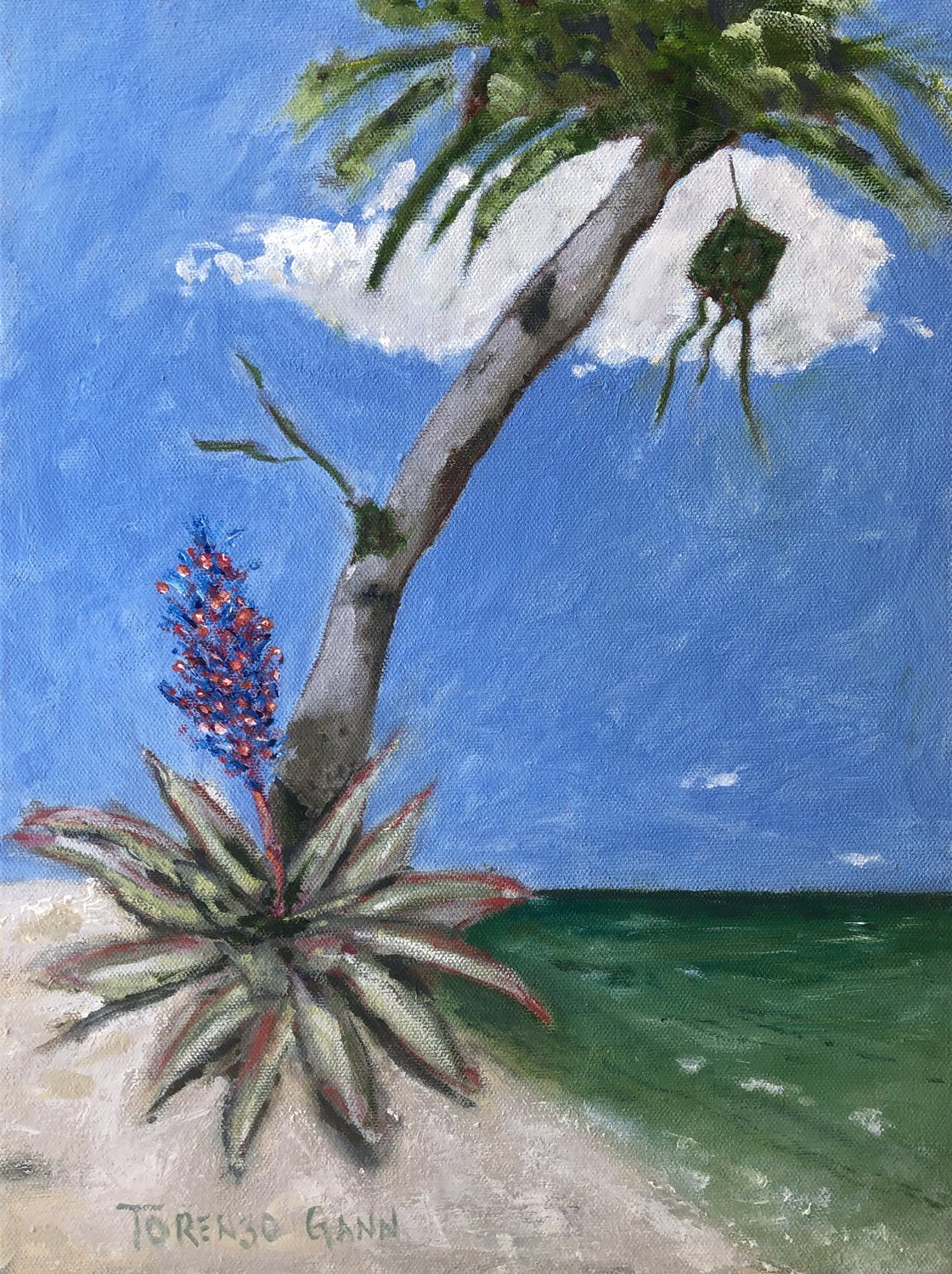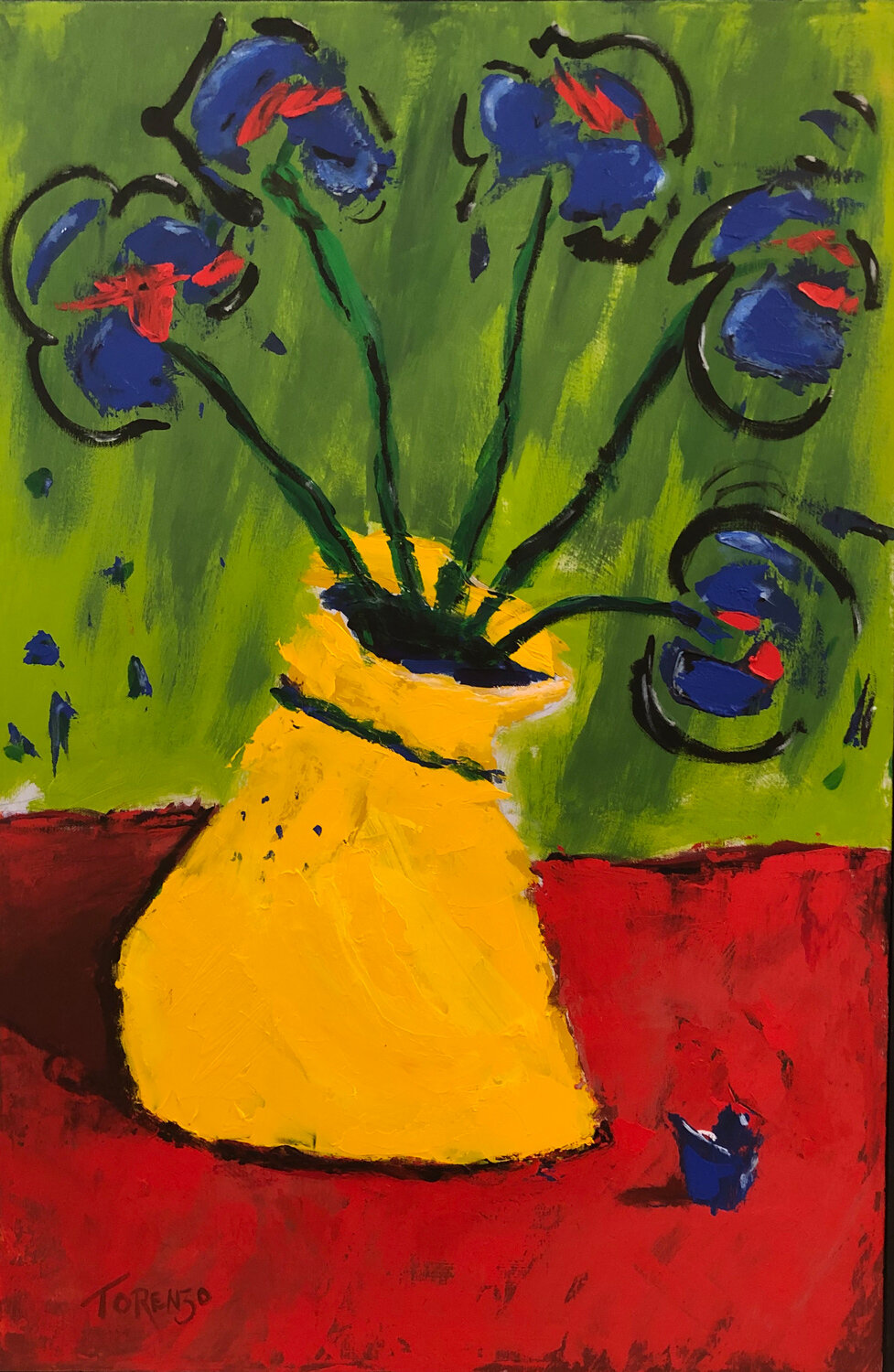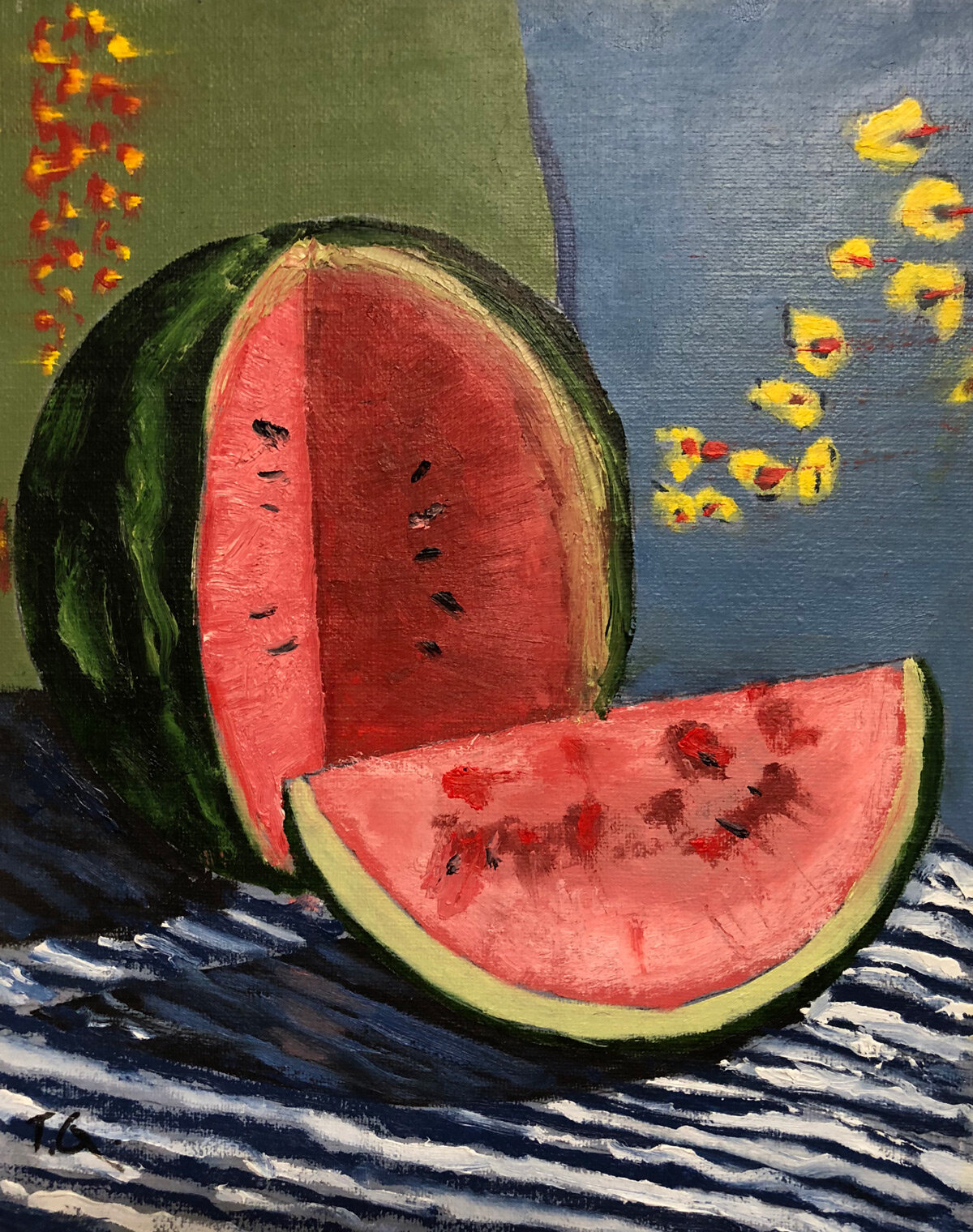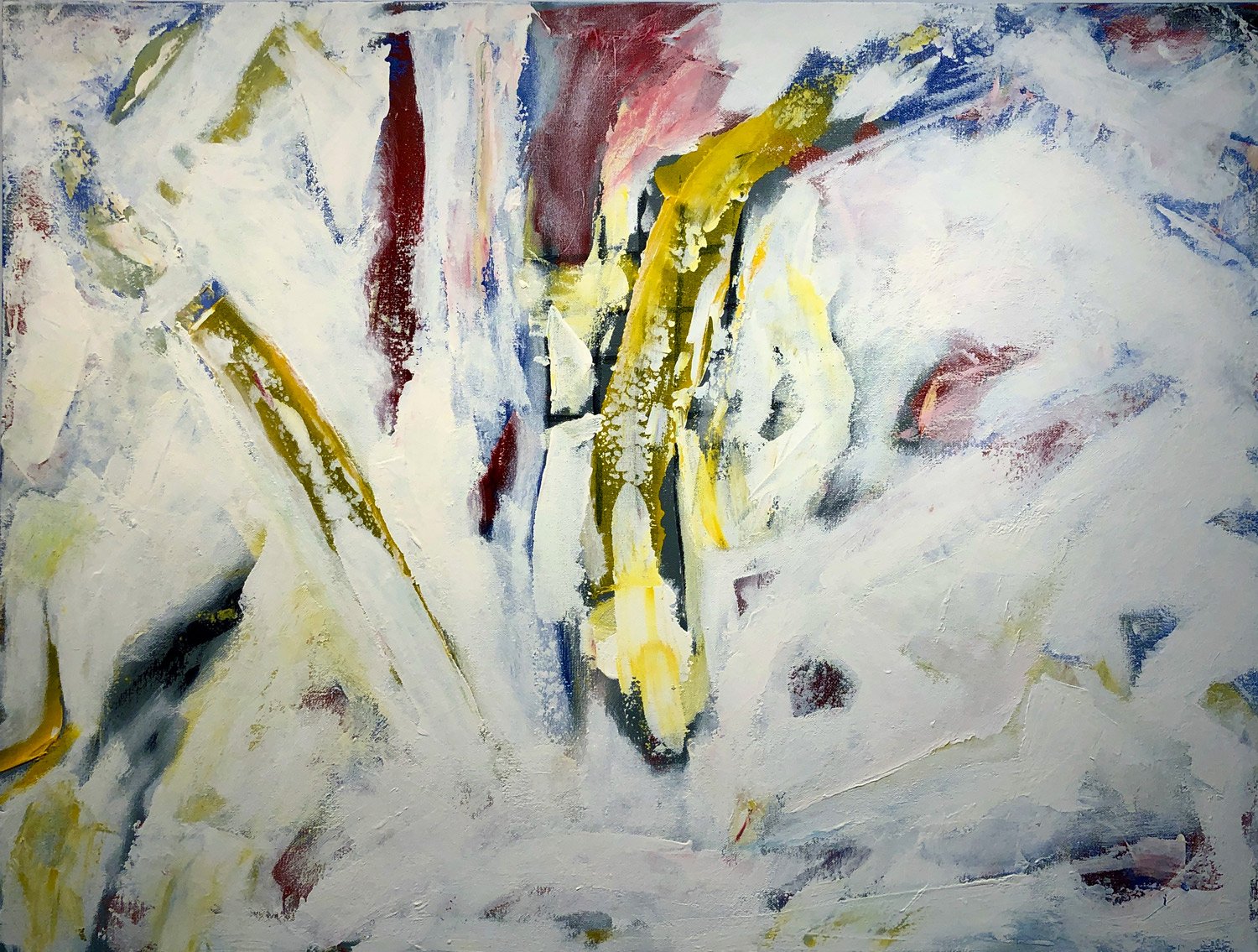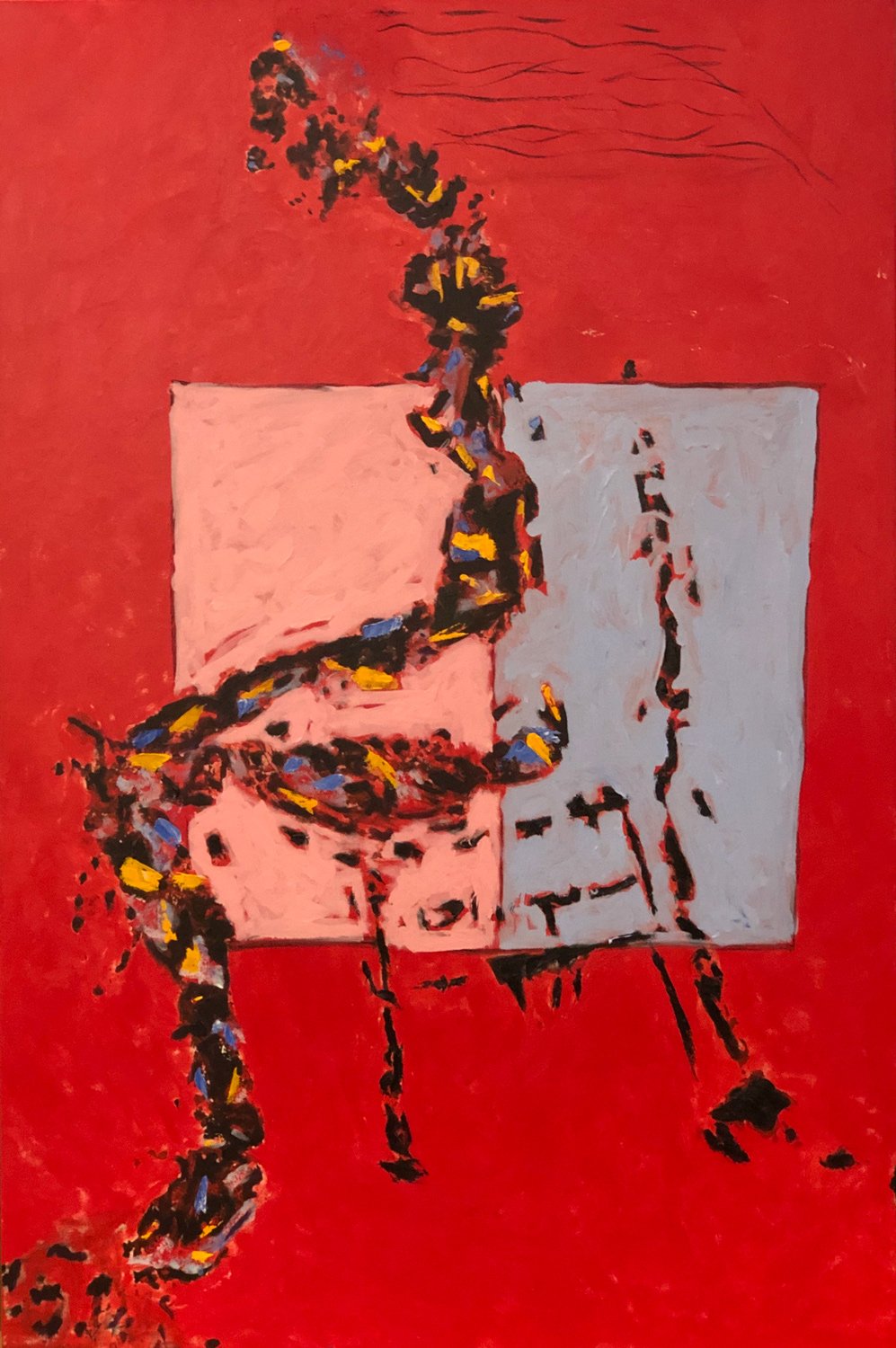Main Gallery
Contentment, 30"x40", Acrylic on Canvas
Black-eyed Susans Dancing Through The Day, 40"x30", Acrylic/Mixed Media on canvas
Constant Joy, 30"x40", Acrylic on Canvas
"Neckoteimus" - Patron Saint of Neckties, 20"x16", Oil on Linen
Sunflower in Vase, 16"x12", Oil on Canvas
Morning Sun, Oil on canvas, 8”x10”
Festival at the Beach, 14"x11", Oil on Canvas
Summer Breeze, Acrylic, 36”x24” SOLD
Cake, Oil on canvas, 8”x10”
Daydream, Oil on canvas, 12”x16” SOLD
"ON" - Light Switch, St. Petersburg, Oil, 10”x8” SOLD
Angel's Trumpet, Oil on canvas, 10”x8” SOLD
Gate Hook, Barbados, Oil on canvas, 10”x8” SOLD
Oil on canvas, 20"x16" SOLD
Obelisk, Bonaire, Netherlands Antilles, Oil, 10"x8" SOLD
Watermelon, Oil on canvas, 10"x8" SOLD
Bogotá, Oil on canvas, 20”x16” SOLD
"Galloping Gertie" - The Tacoma Narrows Bridge Collapse, Giclée Limited Edition of 10, 27"x30"
Abstract
Salt Air
Social Relevance
Social: Relation to the matter at hand / practical and especially social applicability
Relevance: Of or relating to human society, the interaction of the individual and the group, or the welfare of human beings as members of society
As an artist, I believe I have a responsibility to…
Create works of art that bring attention to important societal issues such as chemicals as food additives, toxic chemicals used in the industrialized production of crops, and genetic engineering.
Be concerned about and bring to light the current trend in America of whitewashing our history in order to oblige the politically correct community.
Comment on other issues that create negative circumstances that may affect one’s welfare.
Cancel Culture, Mixed Media Assemblage, 21”x17”
Buckshot Toast, an Homage to Monsanto, Acrylic, 14”x11”
Trapped, Mixed Media High fired clay, barbed wire, gold-filled wire, electrical connectors, rice on gesso substrate, 22” x 17.5”
Deja-Vu, Mixed Media collage on d'Arches hot press paper, 24”x20”
Summer Vacation, Acrylic, 24”x18”
The Last Roundup, Mixed Media Assemblage: Original toast from 2012, stainless screws and washers, spent .45 cal. shells, acrylic, graphite, rice paper, and target on gesso substrate, 20"x16"
Suicide Toast, Acrylic on canvas, 20” x 24”
Death Spud - Idaho Potato, High Fire Clay, 51”x14”14”, 32.5 lbs.
Sculpture
The Story Behind the Work…
Neckotiemus - The Story
Historical Facts
“The necktie has its roots in military history. For starters, a collection of terracotta sculptures discovered in 1974 in Xian, China gives insight into the style worn by Chinese soldiers over a thousand years ago. China’s first emperor, Qin Shin Huang, wanted his army to be buried with him as his guardians in the afterlife. Lucky for all the soldiers involved, his advisors convinced him instead to have life-sized replicas of his troops made to be used as his protectors throughout eternity.”
“In 210 BC when he died, his terracotta “army” in this way-was buried with him. Each statue wore a wrapped neck cloth, the earliest predecessor of the modern tie.”
John Starr, former NBC News producer.
The Origin of the [modern] Necktie
“Most sartorialists (those interested in fashion) agree that the necktie originated in the 17th century, during the 30 years war in France. King Louie XIII hired Croatian mercenaries who wore a piece of cloth around their neck as part of their uniform. While these early neckties did serve a function (tying the top of their jackets that it), they also had quite a decorative effect- a look that King Louis was quite fond of. In fact, he liked it so much that he made these ties a mandatory accessory for Royal gatherings, and to honor the Croation soldiers – he gave this clothing piece the name ’La Cravat’ – the name for necktie in French to this day.”
www. tie-a-tie.net
Neckotiemus, Patron Saint of Neckties
But wait! There’s more!
While there’s ample information about the origin and history of the necktie, there’s a rather interesting, albeit unsubstantiated folklore regarding its history as well.
According to the legend, Neckotiemus, an aspiring fourth century clothier and fashion designer, turned the Bedouin fashion world on its head by abandoning the customary sheep’s wool cloth in favor of fine silk fabric and linens in his robes. This daring and heretofore unheard move, along with the simple, but functional elegance of his designs, attracted a more affluent clientele. Neckotiemus, quite possibly the father of mass marketing and today’s popular box stores, was a social activist, refusing to use animal skins for his garments.One of his early marketing discoveries was the “tent sale”, where he offered special pricing for quantity buying. His competitors often complained that his market stand was a huge box tent and that they couldn’t compete with his prices. Neckotiemus posted signs at his massive tent sales- ”לא נפגעו בעלי חיים “- NO ANIMALS WERE HARMED IN THE PRODUCTION OF ANY GARMENTS.
He was also an advocate of “free range chicken eggs” but struggled to get a low cost “free range” barn yard established, Neckotiemus, reluctantly but finally, abandoned the idea when, to his dismay, a competitor poached his idea.
As Neckotiemus’ business grew, his sharp negotiating and bartering skills created enormous wealth, and his business became an astronomical success
In spite of his great accomplishments, Neckotiemus felt restless. Ready for a change in scenery and a brand new challenge, Neckotiemous set out for Italy. Little did he know that his pilgrimage would impact the future of fashion and fulfill his destiny!
Italy exceeded his expectations! The architecture! The food! The FASHIONS!
He found the Italians warm and high-spirited. Their fashions were astounding; especially those he saw in Milan. Many of the red and black fabric designs reminded him of home and the garments his ancestors wore.
His mind’s eye was filled with a flurry of designs and patterns. He imagined scarves, towels, and shawls. He saw them on people’s heads and shoulders. Then suddenly, in a flash of light, the idea struck him like an enormous bolt of lightning! A garment for the NECK! YES! That’s it!
And it shall be called the Neckgar!
It had been nearly twelve hours since Neckotiemus had eaten. Famished, he thought “I’m hungry for Chinese” and off he went to the local Chinese food stand.
Turning the corner, he discovered Fung Shui’s Chinese Bistro. Fung Shui, the proprietor, was elderly, very wise, and a descendent of a general in Emperor Qin Shin Huang’s army and a pretty good cook.
Neckotiemus ordered Moo goo gai pan (without chicken). While Fung Shui prepared his take- out order she noticed how excited Nekotiemus appeared. So, in broken Latin they conversed at length about his concept. Fung was able to provide Neckotiemus with her knowledge of Chinese military history of the neck cloth. In fact, it was Fung Shui who suggested that his neck cloth be called the necktie, since those words were in his name, and that his cloth be tied around the neck. Neckotiemus was reluctant to agree but assured Fung that he would give it his strong consideration. Finishing his meal, he smiled and thanked her for her suggestions.
As Neckotiemus was leaving Fung handed him a fortune cookie that he opened and read while walking back to his hotel. “Be mindful of the wisdom of your elders.” In that moment the necktie was named and Neckotiemus’s destiny established.
It would be centuries until Neckotiemus was canonized as the patron saint of neckties.
Cancel Culture - The Story
2020 was the most crazy and amazing year for science fiction.
Wait. It wasn’t fiction was it?
So many events that actually happened were absolutely preposterous! It’s hard to imagine Gene Roddenbury of Star Trek fame, and Ray Bradbury, author of Fahrenheit 451 and other science fiction works, would not have penned stories or scripts about what’s happened in 2020.
Before proceeding, I want to make it perfectly clear that I believe that the United States of America has numerous social problems. Furthermore, not for one second would I suggest or imply that what’s happened doesn’t matter, nor would I intentionally make light of these events.
However, the use of protests, demonstrations and riots by various groups, to bring attention to their issues, in my opinion, has weakened and diluted their cause.
As a society and culture, Americans must not forget or erase our history.
The only way to not repeat adverse history with all its atrocities and injustices is to preserve the record of them.
When historical monuments are removed and/or destroyed, textbooks are rewritten, removed, or destroyed, history stops.
“History has stopped. Nothing exists except an endless present in which the Party is always right.”
“He who controls the past controls the future. He who controls the present controls the past”
“The party seeks power entirely for its own sake. We are interested solely in power, pure power.” -- George Orwell, 1984
Accurate history must be preserved and available to the citizens of the world.
The Last Roundup - The Story
Creating artwork with social relevance began in 2012. I was looking for some reference material on the bookshelves in my studio when I came across a piece of toast that I used in another project six months prior. When I found it, I was shocked! It hadn’t changed. At all! The toast was completely intact.
Amazingly, it still looked good enough to eat. It was mold free, and lacked evidence of any interest from insects or other critters (tho that’s not a common concern in my studio).
After that discovery, I quickly found myself in the local supermarket reading the labels on bread and other baked goods. I was amazed at the vast number of chemicals contaminating the recipes. These chemicals are toxins!
In my research I discovered that there are a vast number of over-the-counter foods, beverages, and personal care products containing glyphosate.
The main culprit is glyphosate most commonly found in an herbicide known as Roundup, manufactured by the Monsanto Corporation.
Traces of glyphosate (Roundup) have been detected in many if not all root vegetables such as potatoes, carrots, and lettuce, etcetera.
Other contaminated products include beer, breakfast foods, orange juice, honey, baby food and many natural water sources that affect wildlife, fish, and their environments.
More alarming still, was learning that glyphosate has been detected in the milk of mothers who breastfeed their infants! It seems there is no escape.
“For the first time in the history of the world, every human being is now subjected to contact with dangerous chemicals from the moment of conception until death...These chemicals are now stored in the bodies of the vast majority of human beings, regardless of age. They occur in the mother’s milk, and probably in the tissues of the unborn child.”
- Rachel Carson, Silent Spring
In recent years a urine test has been developed and utilized to detect the presence of glyphosate in the human body.
https://vaccinedeaths.com/2019-01-24-vaccines-are-contaminated-with-glyphosate.html
In August, 2018 Bayer/Monsanto was ordered to pay $289 million to plaintiff Dwayne Johnson for injuries caused by the use and exposure to Roundup setting a precedent for future legal cases.
Trapped - The Story
This mixed media work emanated from a series of drawings of neckties I created some years ago. I originally imagined them as free-standing independent sculptures. But seeing them after they were fired in the kiln, my mind’s eye began envisioning them bound together in the form of a triad. Then I began visualizing the ties as metaphors for executives in a corporate boardroom setting. Then I thought, …“Are they ‘yes’ men or women?” “ Maybe”, I thought. Or are they simply trapped by their own unconscious devices?
After several weeks, other elements were added - Barbed wire wrapped with gold wire, and electrical connectors.
As I studied it, a few more months passed. It needed something more - something to convey the symbolic toll that happens when one is so driven for success and wealth that they lose sight of everything else.
And then…Eureka!
I found myself gleefully sorting through a collection of Dresden figurine fragments. There they were - broken and dismembered body parts - the final pieces needed to complete the work.
“Greed is a bottomless pit which exhausts the person in an endless effort to satisfy the need without ever reaching satisfaction.” – Erich Fromm
Death Spud-Idaho Potato - The Story
This mixed media sculpture is the result of reading the book listed below and additional research.
The potato is a fundamental world-wide food staple ranked 4th after wheat, corn, and rice. Incidentally, each of these staples have been contaminated by chemicals, namely glyphosate, commonly known as Roundup.
According to a recent Northern Plains Potato Association report each American consumes on average 110 pounds yearly, Europeans consume twice that amount.
During my research on toxic chemicals, especially glyphosate, a friend gave me a copy of Seeds of Deception (written by Jeffery M. Smith). I was dismayed and quite disturbed by what I learned in the book about engineered foods commonly called GMO’s (genetically modified organisms).
The book begins with its author informing us that “an Initiative to End Hunger in Africa using genetically modified (GM) foods was proposed in 2003 by President Bush… his rhetoric was not new. It had been passed down from president to president.”
The author further provides facts and information in what appear to be the creation of alliances, and a master plan that would give the Monsanto corporation (acquired in 2018 by Bayer, think aspirin) world dominance in a world in which natural seeds were virtually extinct.
“Integral to the plan was Monsanto’s influence in government, whose role was to promote the technology worldwide and to help get the foods into the market- place quickly, before resistance could get in the way. A biotech consultant later said ‘the hope of the industry is that over time, the market is so flooded that there’s nothing you can do about it. You just sort of surrender.’”
In the interest of the reader’s time, we move on to “Why the Potato?”
Mr. Smith began his exposé on GMO’s by revealing facts about potatoes and “how scientists were altering the DNA of the potato so it would do something no potato had done before. It was to produce its own pesticide…”
In clinical “…research experiments with GM-fed rats it was determined that the rats had significant structural changes and a proliferation of cells in the stomach and intestines… in the end it was only the rats that ate the GM potatoes suffered the serious side effects…there was some effect from the process of genetic engineering itself that caused the damaged organs and immune dysfunction of the adolescent rats. We used exactly the same methods of genetic engineering as used by the food companies.”
These informative facts clearly identify how one of the world’s major food sources has been aggressively attacked.
Recently President Joe Biden selected Tom Vilsack a/k/a “Mr. Monsanto” as Agriculture Secretary.
It is my hope that this work stimulates thoughts, conversations, and remedies to protect our food sources, our environment, and our physical and emotional well-being.
Deja Vu - The Story
Is there a variation of history repeating itself?
It seems so to me.
Four of my uncles served in the military during World War II. One in the US Army Infantry in Europe, one in the Army Air Corps in North Africa, and the third in the US Navy during the Japanese attack on Pearl Harbor.
My wife’s mother and grandparents lived in Germany when Adolf Hitler was chancellor. After witnessing Hitler’s rise to power as Führer and the brutal attacks on the Jews and Germany citizenry that followed, causing massive racial strife, they returned to America.
As a child and then young adult I listened to my relatives’ personal accounts of their experiences during the years of that war.
From their stories I see alarming parallels in today’s national events: hatred, racism, bigotry, and calls for reeducation camps and ethnic cleansing for those that hold different views and opinions.
What do you see?
Reconciliation - The Story
I invite you, the viewer, to immerse yourself into this experiential creation and imagine that you are a figure in one of the thirty-eight windows.
Within each window, there are abstract images representing yourself, people you know now, or from the past. They may be loved ones, current friends, or broken relationships.
Notice the palette of colors and the lines connecting one window to another.
Gold
Represents the beauty and individuality of every human being, past and present, and their unique preciousness.
Blue/Gray
Represents the current accumulation of one’s emotional and psychological experiences, good, and bad, hurts, disappointments, betrayals.
Red/Orange
Represents the life-force, the God/Creator of your understanding and His influence and impact on your life. Reconciliation and restoration of relationships.
White
Represents the purity and imperfections of life.
The Lines
Represent the connectedness, or the brokenness, in the relationship(s).
Notice the lines. Many are connected, one with another, to another and so on. Some are strongly connected. Some are barely connected. Some are not connected at all.
So, where are you?






